We begin our journey from the
ancient city of Amphipolis, located at the mouth of the Struma
River, along the north Aegean coast.
In the area of Nine Roads opposite
Amphipolis there was an important ancient settlement, an important
crossroad center in antiquity since the time of the Iron Age.
Appreciating the important strategic importance of this region the
Athenians managed to found their colony Amphipolis in 437/436 BC
after two failed attempts.
The city was built high on a hill
and on both banks of the Struma River, from where it took its name.
The city controlled the whole region along the Struma River, part
of the ancient road, known during the Roman era as Via Egnatia
which led to the interior of ancient Thrace. Amphipolis also
controlled gold and silver mines in Pangaion Mountain.
Perennial archaeological research
has revealed important parts of the ancient city. Among them are
sections of the outer and inner fortified wall, five of the
fortress gates, the ancient bridge over the Struma River, the
gymnasium, the sanctuaries of Attis, Clio, Thesmophorion.
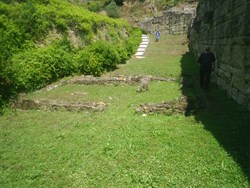 |
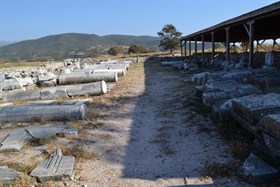 |
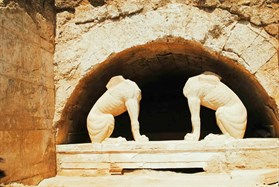 |
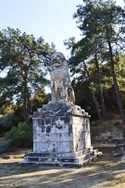 |
| 1. The Thesmophorion |
2. An early Christian
basilica from the
Acropolis of the town |
3. Sphinx from the entrance of
the tomb.
Photographer Katerina Peristeri |
4. А statue of the next
to the Struma River |
of the town.
Five spectacular early Christian basilicas were studied in the
Acropolis of the town.
Five spectacular early Christian basilicas were studied in the
Acropolis of the town.
Residential complexes of the ancient city dating back to the
Classical, Hellenistic and Roman periods have also been
studied.
The necropolis of the town were revealed and studied outside the
fortified wall and several monumental tombs of Macedonian type
were found there. Among them the monumental tomb beneath the Kasta
mound shines with the greatest power. It is located east of the
ancient town. A monumental staircase with sixteen steps leads to
the first room where two marble sphinx are located at the
entrance.
The floor is decorated with stone
geometric flooring. Two majestic caryatids on a marble pedestal can
be seen in the second premise. In the third premise behind the
caryatids there is an antique mosaic presenting the scene: God
Pluto abducts Kore-Persephone to the underworld. According to the
mosaics and sculptural decoration the tomb dates back to the last
quarter of the 4th century BC. A monumental marble gate leads to
the fourth room where the main burial chamber of the monument is
located.
Archaeological Museum of Amphipolis
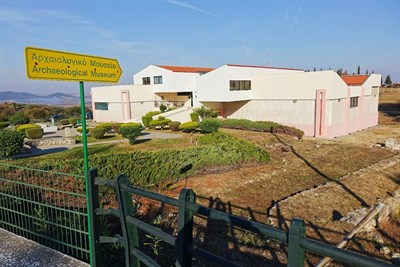 |
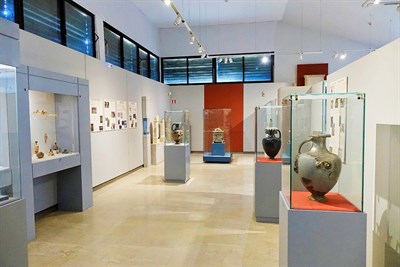 |
5. Archaeological Museum of
Amphipolis. Exterior.
Photographer Dr. Krum Ivanov |
6. Archaeological Museum of
Amphipolis. Interior.
Photographer Dr. Krum Ivanov |
It is located inside the outlines of the ancient city of
Amphipolis. The most important exponents in the museum are the
prehistoric and Thracian pottery, gold jewellery from Amphipolis
necropolis, a small ceramic sculpture from the Classical and
Hellenistic period -images of Aphrodite and Eros, of Cybele and
Attis. Special attention is given to the marble burial steles from
the Hellenistic period, as well as the marble votive plates
dedicated to the Dioscuri and the river god Strymon, the Great
goddess Cybele and the Thracian horseman.
Among the epigraphic monuments, the
law of the Amphipolis gymnasium, which is preserved in a very good
condition, should be noted. The museum has a rich collection of red
and polychrome Hellenic ceramics, terracotta figures, as well
as monuments of jewelry dating from the Classical and Hellenistic
epochs.
A special accent in the exposition
is placed on a silver reliquary with a golden olive wreath,
which probably belonged to the Spartan commander Brasidas who died
here in battle with the Athenians in 422 BC, and a golden wreath
coming from a male burial.
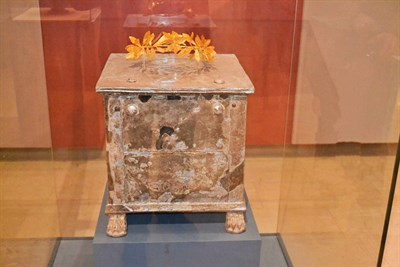 |
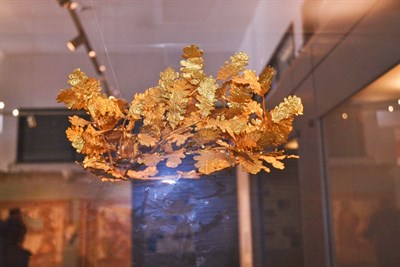 |
| 7. The silver reliquary and the
golden wreath the Spartan officer Brasidas |
8. A golden wreath of oak
leaves |
We continue our journey to the
north to the ancient and medieval city of Serres.
Serres was first mentioned as Siris
by the Greek historian Herodotus, the father of history, in the 5th
century BC. It is also mentioned as Siras by Titus
Livius as Siras, as well as by
other ancient authors. The city had an important geo-strategic
location on the road along the Struma River which in ancient times
was navigable up to Kerkini Lake. During the Roman era the city was
mentioned in literary sources as Sirra, Sirraion. During the
Byzantine era Serres is known as а big, strong and rich city, the
capital of the Theme of Strymon. The most famous monument of
the Byzantine era in Serres is the tower of the Acropolis of
the city. It is known as the Tower of Orestes. It served as a
donjon - a place for the last defense of the fortress
defenders.
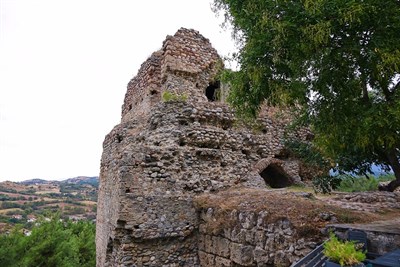 |
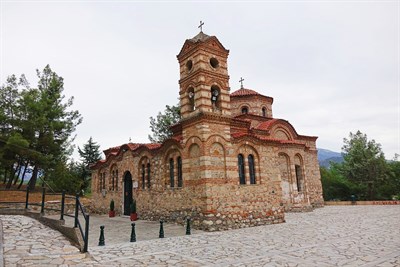 |
9. The tower- donjonat the
Acropolis of Serres.
Photographer Dr. Krum Ivanov |
10. St. Nicholaschurch atthe
Acropolis of Serres.
Photographer Dr. Krum Ivanov |
The church of St. Nicholas at
the Acropolis of Serres also dates from the Byzantine era (XII
century AD). It functioned as a cemetery temple with a
crypt.
The church of St. Theodor Tyron and
Theodore Stratelates known as the old Metropolis is very
interesting as an architectural monument from the
Byzantine era. It is considered to be the most important
cultural and historical monument in Serres. The temple
functioned as a metropolitan church throughout the Byzantine
period and later.
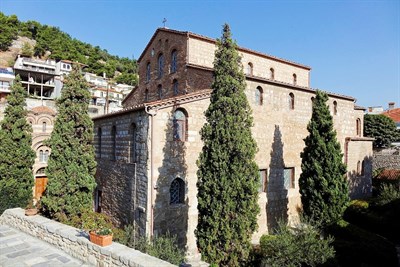 |
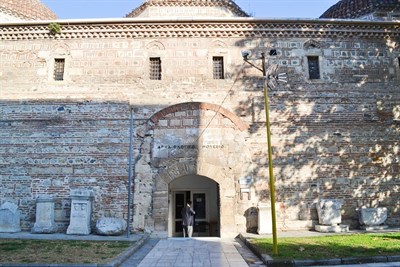 |
| 11. Serres.The old Metropolis.
Photographer Dr. Krum Ivanov |
12. Serres. Тhe Archaeological
Museum "Bezisten" |
Archaeological Museum of Serres
Тhe Archaeological Museum
"Bezisten" is located on "Eleftheria" square of Serres. The
building dates back to the 15th century.
After being restored and renovated,
it is now functioning as an archaeological museum where the
archaeological finds from Serres district of all periods are
located. A special place in the exposition is dedicated to the tomb
reliefs of the Roman era. They are a specific group representing
the Roman portrait in the region and they show close contacts of
culture from the Roman era with the region of Middle Struma (the
regions of modern cities Sandanski and Blagoevgrad in
Bulgaria).
Particularly impressive are the
Early Christian and Byzantine exhibits from the town of Serres,
Most notably among them are the marble icon of Christ and the
twelfth-century mosaic of St Andrew the Apostle. The icons come
from the old cathedral of Serres.
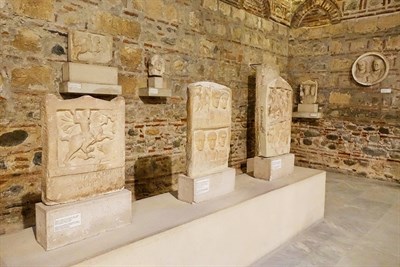 |
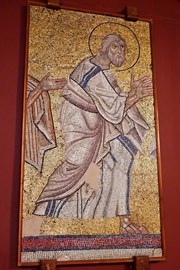 |
| 13. Tombstone reliefs. Roman
age. Photographer Dr. Krum Ivanov |
14. St. Andrew the
Apostle |
We continue our journey north. We
cross the Greek-Bulgarian border at Promachonas / Kulata and head
for the late Roman city at the modern town of Sandanski.The ancient
city lies under the modern one. The earliest Thracian settlement
here arose around the mineral springs in the 2nd millennium BC. The
region falls into the tribal territory of the Thracian tribe Medi
from which Spartak comes - the leader of the greatest slave
rebellion in the Roman Empire in 73-71 BC. In the 2nd and 3rd
century AD the settlement was given the status of a city. In the
3rd-4th century the Roman city at modern Sandanski occupied 20
hectares of land and was fortified with a fortress wall. Many
researchers now identify it as the ancient city of
Parthicopolis.
In the 6th century AD the Roman
town at Sandanski is one of the earliest and most significant
episcopal centers in the territory of Bulgaria. Archaeological
studies have revealed 7 early Christian basilicas. With its
grandiose architecture and exceptionally rich artistic decoration
the Episcopal Complex is the most representative ensemble in the
ancient city of Parthicopolis in the 5th - 6th centuries.
The Episcopal Basilica has an
atrium (inner courtyard with a well) and a narthex. There is a
well-preserved pulpit, an altar, and a synthronon with three rows
of seats in the naos. The complex also includes a baptistery which
is remarkable for its shape and size.
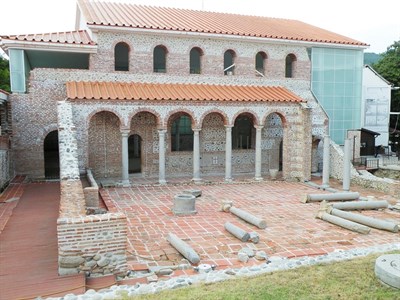 |
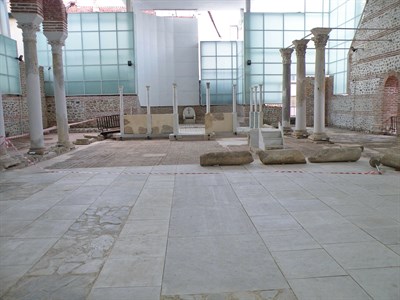 |
| 15. The Episcopal Basilica. A
view from the south |
16. The Episcopal Basilica.
Interior |
The martyrium is one of the most
important discoveries in the Episcopal Complex. It is placed in the
northwestern part of the complex and has a richly decorated altar
table with niches for the preservation of relics and a spring with
holy water.Magnificent mosaics in opus tessellatum and opus sectile
style were found here.
Archeological museum of
Sandanski
The Archaeological Museum of
Sandanski was founded in 1936.Today, the museum has a 400 m²
exhibition area, spread over two floors in three exhibition
halls.
Exhibits of prehistory and
antiquity are presented in the two halls on the second floor. The
first floor is situated above the foundations of the Early
Christian Basilica from the 5th century, known as the Basilica of
Bishop Yoan.
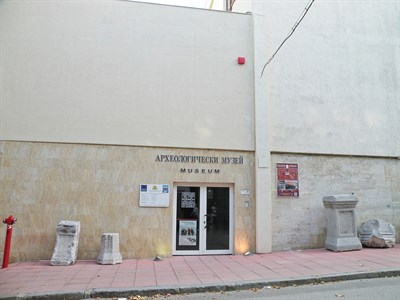 |
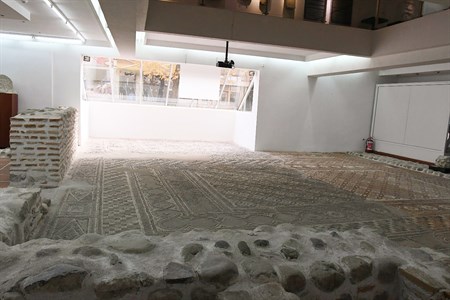 |
| 17. Archeological museum of
Sandanski |
18. A floor mosaic from the
Bishop's Basilica.Photographer Dr. Krum Ivanov |
In the museum there is a unique
collection of Roman gravestone marble plastic art (1st - 3rd
century) typical for the Middle Struma river valley. Real
masterpieces of antique art are the steles of Julius Maximus,of
Asclepius, the gift stele of Flaviana Philocratia and others. The
collection has also various votive steles dedicated to Artemis,
Heracles, Zeus and Hera, the local deity Teos Selenos and others,
as well as statue replica of a famous copy of Aphrodite.
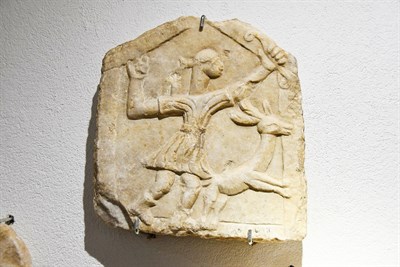 |
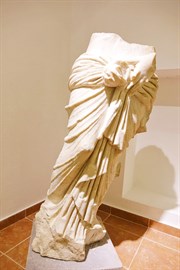 |
19. A votive stele of
Artemis.
Photographer Dr. Krum Ivanov |
20. A statue of Aphrodite.
Photographer Dr. Krum Ivanov |
We continue our journey north against the Struma River. A
fortified late antique building was studied archeologically by the
Regional Historical Museum of Blagoevgrad 16 km west of Blagoevgrad
near the village of Drenkovo.
The region has been populated since
the prehistoric age. A road linking the valleys of the rivers
Struma and Vardar was passing along the Drenkovska River during the
Late Antiquity. This road guarded the monumental square fortified
building located south of the village of Drenkovo. It is equipped
with semiround towersin its four corners. The building was
constructed in the typical of the late-Roman fortress Opus Mixtum
style meaning "mixed work".
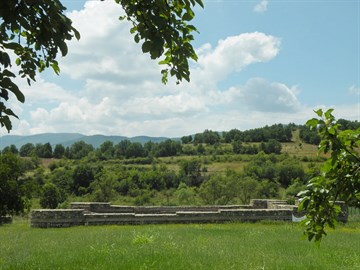 |
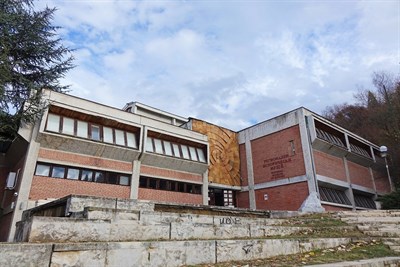 |
21. A fortified late antique
building near the village
of Drenkovo, Blagoevgrad municipality |
22. Regional History Museum
in
Blagoevgrad |
Regional History Museum of Blagoevgrad
The museum was founded in 1952
year. It has a well-established structure consisting of departments
of "Archaeology", "Ethnography", "Bulgarian lands from the 15th to
the beginning of the 20th century", "New and Modern History",
"Nature", "Art department", "Funds", "Public Relations", modern
laboratories for preservation and restoration.
The Regional History Museum in
Blagoevgrad has a big collection of early Neolithic clay stamps -
pintaderi. It is the largest in Europe. The most significant clay
stampsare exhibited in the "Prehistory and Antiquity" hall.
Unique samples of Thracian weapons
from the region of the Western Rhodopes are exhibited. The famous
ancient inscription from Skaptopara is presented here. It testifies
about the Thracian-Roman settlement near the warm mineral springs
preceding Blagoevgrad. In the same hall are exhibited some of the
best samples and collections originating from the region of
Southwest Bulgaria and owned by the museum - Thracian, Hellenic and
Roman ceramics, metal vessels and tools of labor dating back to the
antiquity, reconstructions of antique crafts and ancient Thracian
funerary monuments.
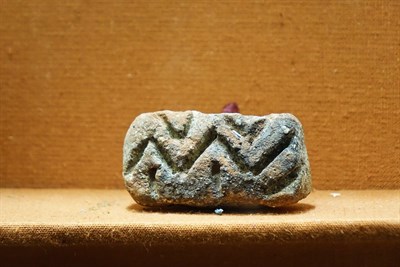 |
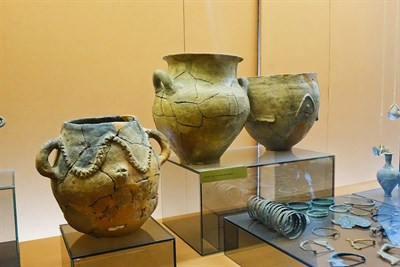 |
| 23. A clay stamps - pintadera.
Photographer Dr. Krum Ivanov |
24. Thracian ceramics.
Photographer Dr. Krum Ivanov |
There is a rich collection of
tombstones from the Roman era. In the Middle Struma valley, they
form a very characteristic group which differs to a great extent
from the monuments in the rest of Bulgaria, both in their size and
shape, as well as in the depictions in the relief field. They find
parallels in the Roman tombstones kept in the museums of Sandanski
and Serres.
Unique clay colored masks of Satyr
and Bacchantes (known also as maenads) who weremembers of the
retinue of Dionysus - the god of wine and festivity are presented
in the last showcase of the Prehistory and Antiquity hall.
Monuments from the Early Christian
era originating from the region are also exhibited.
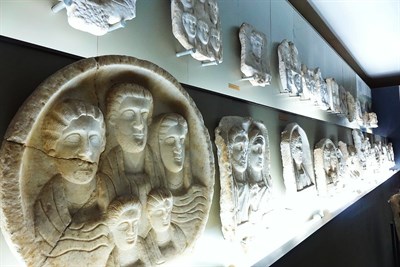 |
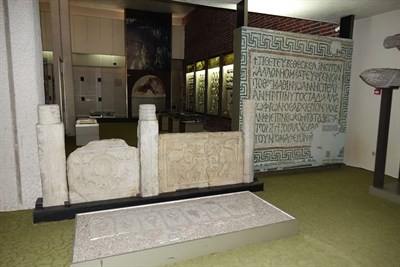 |
25. Tombstones. Thracian- Roman
era.
Photographer Dr. Krum Ivanov |
26. An altar barrier and
mosaics from an early Christian church.
Photographer Dr. Krum Ivanov |